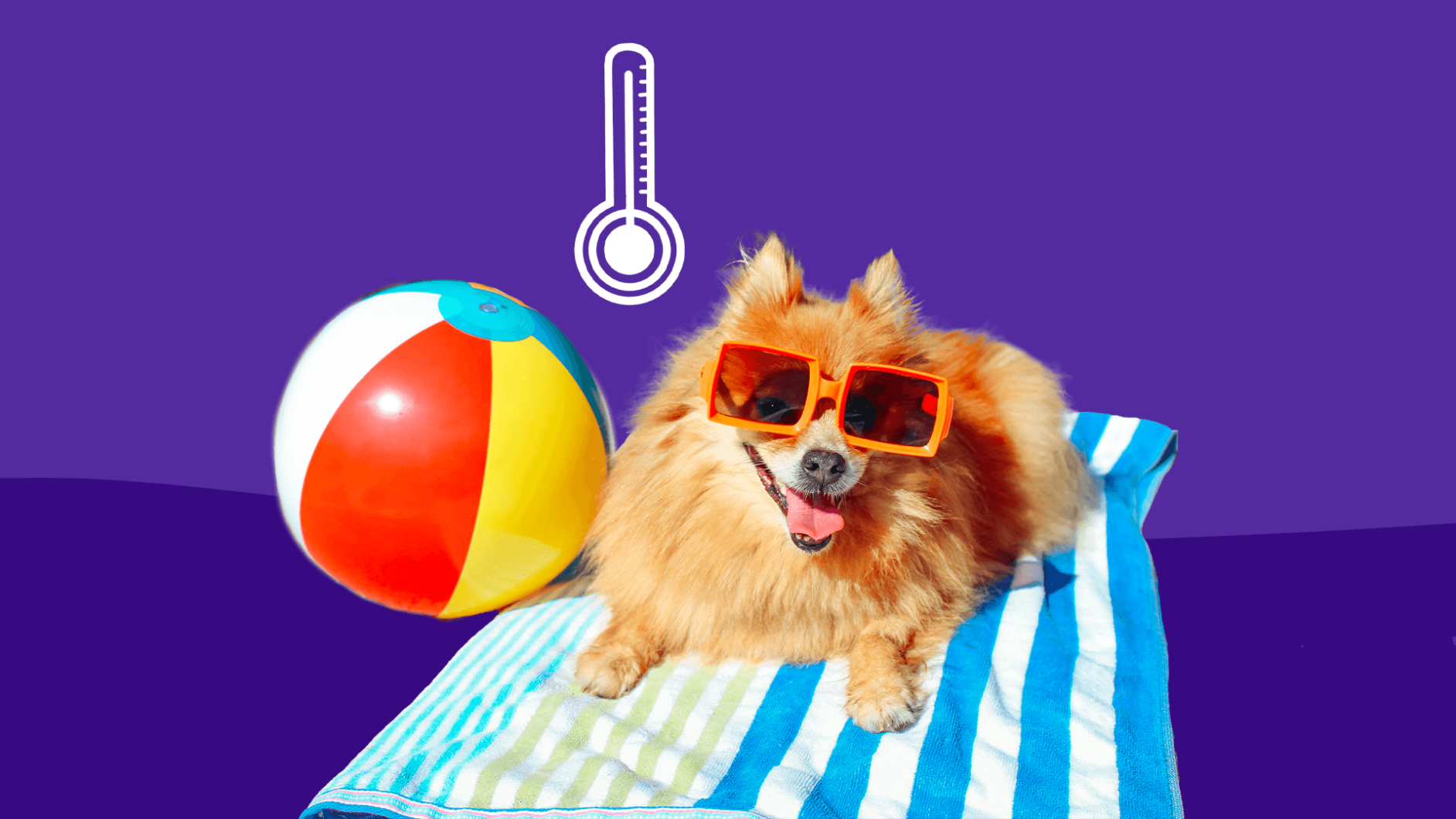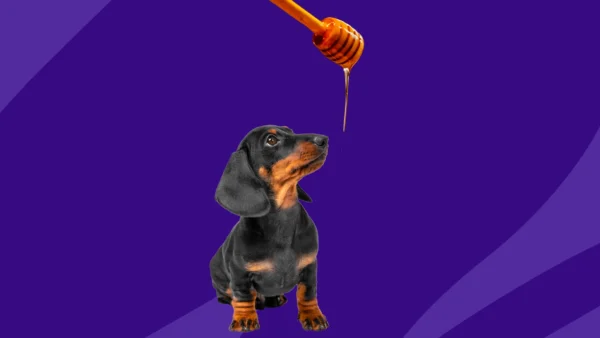Hot summer days mean a lot of time spent outdoors relaxing and enjoying the sun, but they can also lead to dangerous health problems for your canine companion. When your four-legged friend’s body temperature rises above a healthy range, it disrupts the ability to regulate body heat, which can lead to heat exhaustion, also known as hyperthermia.
Mild symptoms of heat exhaustion in dogs like panting, drooling, and feeling warm to the touch can sometimes be managed at home. However, severe symptoms, especially when prolonged, can lead to heat stroke in dogs.
How do I know if my dog has heat exhaustion?
During the summer months, heat exhaustion and heat stroke can quickly occur. But, according to Megan Conrad, BVMS, a licensed veterinarian at Hello Ralphie, heat exhaustion is the first step before heat stroke occurs.
“Heat exhaustion occurs when the dog’s core body temperature reaches 103 degrees Fahrenheit (F), but when the core body temperature reaches 105.8 degrees Fahrenheit, heat stroke sets in, and this can be damaging to the cells within the body,” Conrad says.
This is quite a bit higher than a normal temperature in dogs, which is between 99.5 F and 102.5 F, according to UC Davis Veterinary Medicine.
Here’s where it gets complicated. Dogs do not sweat in the same way humans do. Instead, they pant to help release heat from the body and cool themselves down, letting cold air in and warm air out. Conrad says this puts dogs at an increased risk of heat exhaustion and heat stroke.
Risk factors for overheating include:
- Hot, especially highly humid, environments
- Long-haired and brachycephalic (short-nosed) breeds
- Very young or very old age
- Obesity
- Excessive exercise without a break
- Lack of access to water
Dogs who are in a confined area like a car with no airflow or direct sunlight are at high risk of developing heat exhaustion.
RELATED: How to keep pets calm during the 4th of July
How do dogs act when overheated?
Knowing the signs of heat exhaustion in your dog can help prevent them from getting too sick. According to Sara Ochoa, DVM, a small animal and exotic veterinarian in Texas and veterinary consultant for DogLab, the symptoms of heat exhaustion in dogs are similar to what humans experience, but dogs pant in an effort to cool themselves.
Some of the more common signs of heat exhaustion in dogs include:
- Excessive panting
- Drooling
- Feeling warm to the touch, especially their ears
- Vomiting
- Red gums
- Rapid or increased heart rate
- Quiet or lethargic
- Not responding to verbal cues or touch
- Lying down and refusing or being unable to get up
- Bloody diarrhea (more common in heat stroke)
- Muscle tremors (more common in heat stroke)
- Ataxia or staggering gait (more common in heat stroke)
- Seizures (more common in heat stroke)
- Coma (more common in heat stroke)
The signs of heat exhaustion in dogs typically occur when their body temperature is under 105.8 F. But if the body temperature is greater than 106 F, permanent brain damage may occur. Prolonged increases in temperature can also cause damage to proteins in the body creating bleeding issues and organ damage.
RELATED: How to create a pet first aid kit—and why you should
How do you treat heat exhaustion in dogs?
If your pup is experiencing any of these signs, you need to act fast. The sooner your dog is treated, the better the prognosis. First, call your veterinarian right away. They may recommend immediate emergency medical treatment at a 24/7 animal hospital if your pup is too sick for an office visit or treatment at home.
If home treatment is recommended, make sure your pet is in a shaded area or a room with air conditioning. You can also offer them cold water to drink and place a thin wet towel across their body.
Once you arrive at the vet’s office or emergency animal hospital, the vet and assistants will act quickly. Your dog may need active cooling, intravenous fluids, and oxygen. They may also require medicine to support the central nervous system or normalize their heart rate. Most likely, your pet will need to be monitored until they show improvement.
Dr. Ochoa says one of the first things your vet will do is give your dog IV fluids to help cool their internal body temperature. Your veterinarian may also pour cool, not cold, water over your dog’s body, head, and feet or place your pup on ice packs, which can help cool your dog’s skin.
If your dog is vomiting, the vet may administer medication to make it stop. More severe cases of heat stroke in dogs can cause seizures, which require administering IV seizure medication to control, according to Dr. Ochoa. Your dog’s blood will also be tested for clotting issues. High temperatures can cause damage to the clotting factors in blood and these bleeding issues can show up days after an episode of heat stroke. If clotting times are affected, plasma transfusions and prolonged hospital stays may be needed.
How long does it take a dog to recover from heat exhaustion?
When treated in time, the prognosis for heat exhaustion and heat stroke in dogs is very good. However, if symptoms persist for too long before intervention, the prognosis is not as hopeful.
According to a 2017 review, a prolonged time lag from the occurrence of the heat insult to the presentation for veterinary care increased the risk of death in dogs. The time lag was identified as greater than 90 minutes.
Based on the results from this review, the researchers recommend intensive and prolonged treatment and monitoring of heatstroke in dogs, since most of the complications have delayed onsets and are serious risk factors for death.
If a veterinarian treats your pup, they will regularly check the dog’s rectal temperature until it reaches 103 degrees Fahrenheit or lower. Once your dog’s body temperature reaches a safe level, the vet will decrease the cooling methods and continue to monitor your dog’s symptoms.
RELATED: The top 10 discounts on pet medications with SingleCare
What are some preventive measures to keep your dog cool?
The best way to keep your pooch safe is to prevent them from overheating in the first place. Although you can’t control the scorching temperatures outdoors, you can implement a few strategies to keep your dog cool when things heat up.
Conrad says ways to prevent heat exhaustion in dogs include:
- Exercise your pet during the cooler part of the day (early morning and late at night) or indoors.
- Keep your dog indoors as much as possible if your pup is in a high-risk category.
- Always have shade and water available for your pet (it is not ideal to keep pets outside in the summer heat).
- Never leave your dog in a car, even with open windows, unless the car is running with the air conditioning on.
- Provide airflow with a fan, a shallow pool, and constant access to shade and water if your pet must be outside in the heat.
A few preventive measures can go a long way to protect your dog’s health.











